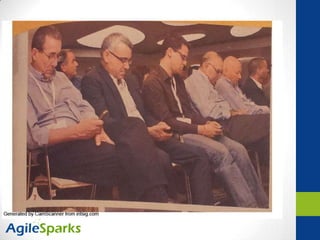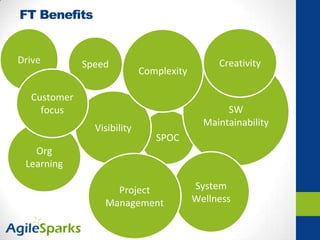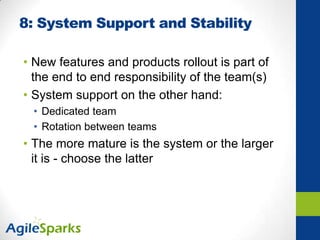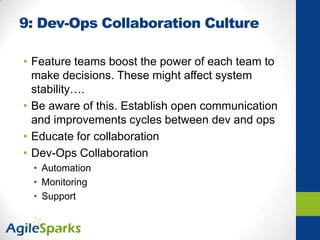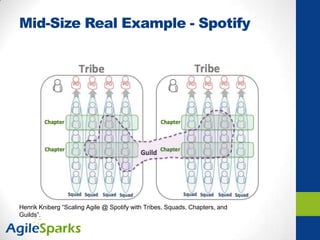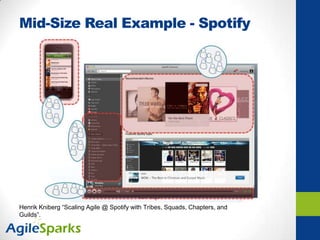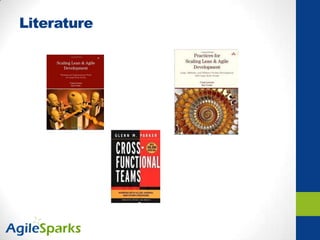Transition to feature teams - Gil Wasserman - Agile Israel 2013
- 1. Transition to Feature Teams – Options, Practices, Guidelines Gil Wasserman Coach, AgileSparks AgileIsrael 2013 7 May 2013
- 4. Lecture Context • Team duration • Stable/Long Lived • Ad-hoc • Virtual • Team members location • Co-located • Distributed • Technical overlap between teams • Full • Minimal
- 5. 1: Define the team Domain • Team Focus/Goal • Strategic goal • Line of business • Product • Super Team • Project/task
- 6. 2: Maximize Autonomy • Maximize the ability of the team to achieve results autonomously • Structure • Processes • Tools and Infrastructure • Environments • Architecture • Coding methods (e.g. feature toggle) • Balance teams (in the long term) • Seniority • Experts • Bonding • Load
- 7. 3: Ownership • With autonomy comes ownership • Educate for end to end responsibility (Done- Done !) • Success and failures are part of the team performance • Team should build short improvement cycles over their results and culture
- 9. 4: Invest in the Technical Landscape • Identify the domains that require expertise: • Component • Sub-system • Knowledge domain • Assign tech owner to lead it • Tech Owner should be: • Responsible of the domain well being, long term health • Production – e.g. Scalability, Performance, Stability • Quality – e.g. Architecture, Coding standard, Coverage • Process - Automation
- 10. 4: Invest in the Technical Landscape • Tech Owners should be: • Enablers of good design and coding • Spreading the knowledge • Rarely (if any) selected participation in the critical delivery chain • Establish Tech Owners Forums and Platforms for collaboration • Tech Owners should allocate 5%-20% of their time to the above
- 11. 5: Build the matrix • Yes, we push for autonomy of the team. • But, Success requires a matrix of collaboration that crosses teams’ boundaries • Cross Teams Collaboration • PMs • Team leaders • Architects/Tech Owners/Experts • QA Engineers and QA programmers • Delivery Engineers • Scrum Masters • . • .
- 12. 6: Think Architecture • Full force ahead towards Biz success should be combined with healthy architecture thinking • System Architects should be involved in major development efforts. • Architects should enable, educate, review and promote system well being. • Make sure Architects have free communication channels to PMs.
- 13. 7: Delivery Automation Included • Push for autonomy of the team including delivery to production • Delivery automation preferably be part of the team skills • Support and enhance the team if needed by external specific team (e.g. QA automation, Deployment automation) • (Regulations issues are solvable)
- 14. 8: System Support and Stability • New features and products rollout is part of the end to end responsibility of the team(s) • System support on the other hand: • Dedicated team • Rotation between teams • The more mature is the system or the larger it is - choose the latter
- 15. 9: Dev-Ops Collaboration Culture • Feature teams boost the power of each team to make decisions. These might affect system stability…. • Be aware of this. Establish open communication and improvements cycles between dev and ops • Educate for collaboration • Dev-Ops Collaboration • Automation • Monitoring • Support
- 16. 10: Transition to Feature Teams • The strength of feature teams structure comes from the focus of the org as a whole to Biz orientation • Its better to have the transition in a single step rather than gradual/pilot way • Be prepared though for a few months with lower efficiency: • Make all the right preparations (Policies, roles, environments etc) • Conduct the change • Stabilize and adapt
- 17. 10+1: Inspect and Adapt • The above guidelines are just what they are • Inspect and adapt continuously in order to reach the balance and the DNA that is best for your organization
- 18. Mid-Size Real Example - Spotify Henrik Kniberg “Scaling Agile @ Spotify with Tribes, Squads, Chapters, and Guilds”.
- 19. Mid-Size Real Example - Spotify Henrik Kniberg “Scaling Agile @ Spotify with Tribes, Squads, Chapters, and Guilds”.
- 21. Questions ?
- 22. Literature
- 23. 0: Leadership, Believe ! No retreat ! No surrender ! PREPARE FOR GLORY !


